 |
|
|||
 |
 |
|||
RINKER ON COLLECTIBLES — Column #1787 Copyright © Harry Rinker, LLC 2021 Questions
and Answers
QUESTION: I have several Arts and Crafts furniture pieces (chairs, coffee table, candlestand, and desk) made by the Mason Furniture Company of Los Angeles, California. What can you tell me about their history? What approach should I take if I want to sell them? – CT, Email Question 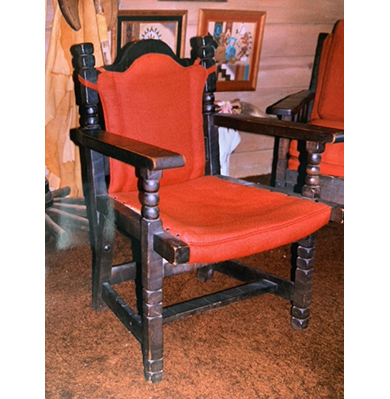
ANSWER: Mason furniture normally triggers an image of furniture made from Oregon alder and painted with a Mexican palette. Your pieces serve as a reminder that Mason also made western-style furniture that derived its roots from California Mission architecture and furnishings, Dutch and Spanish Colonial styles, and ranch furnishings. Decorative elements included images such as branding irons and lariats found in a western barn. These pieces created a “Monterey-style” that was extremely popular on the West Coast in the 1930s. By the early 1940s, the Masson Furniture Company abandoned its Monterey styles and made mundane American Colonial Revival style furniture. Frank Mason and his son George founded the Mason Furniture Company. It made furniture from 1930 into the mid-1940s. Hollywood and Barker Brothers influenced the company’s designs. Barker Brothers approached Frank Mason with the idea of creating a line of furniture and furnishings based on Fox’s 1929 “In Old Arizona, an early “talkie” western movie. Mason furniture blended classic period design styles by combining a number of different stylistic elements into one piece. Because the furniture has the appearance of handcraftsmanship, it is often associated with the Arts and Crafts movement. Your furniture pieces contain a wide range of different historical styles held together by a general western motif. The coffee table is pure “bunk house” western. The chairs range in styles from a liberal interpretation of the classic Queen Anne style to turned spindles and legs reminiscent of the late Victorian era Elizabethan Revival style. The desk combines an Arts and Crafts top with Elizabethan Revival style legs. Judging from the pictures that accompanied your email, your furniture pieces date from the late 1930s or early 1940s. The primary market for George Mason furniture is the West Coast, especially the Los Angeles area. Contact Los Angeles Modern Auctions (www.lamodern.com) to determine what interest they may have. Do not be surprised if they (1) want to cherry pick the collection [take only the pieces they think will bring a high price} or (2) place the lower value pieces into lots, assuming they are willing to take everything. WorthPoint.com contained a few listings for comparable Mason furniture listings. An upholstered lounge chair did sell on eBay in 2019 for $2,000.00. Most comparable chairs sold for less than $300.00 each. You can try to sell the pieces individually on eBay and take your chances, but I do not recommend this. Consider placing an ad in a local antiques or collectibles trade paper. Create a take all or take none pitch. List the collection at “best offer over $3,000.” While an auctioneer may achieve a higher return, remember you will have to pay the auctioneer’s commission and other sale-related costs. Cash in hand is better than gambling on a greater return. The above advice is based on the assumption the furniture is on the West Coast. If east of the Rockies, the furniture will be a tough sell. 
QUESTION: During our childhood, we saw a lamp consisting of a rayed glass base and checkered glass, tall cylinder ending in a dome top. The lamp always was in pieces. We recently found the pieces when going through our attic. We had the lamp rewired and assembled. The are no identification markings on the lamp. Our grandfather worked as a master glass blower for Imperial Glass in Bellaire, Ohio, back in the 1930s and 1940s. We would appreciate any insights you can provide about this lamp’s history and monetary value. – B&SB, Email Question 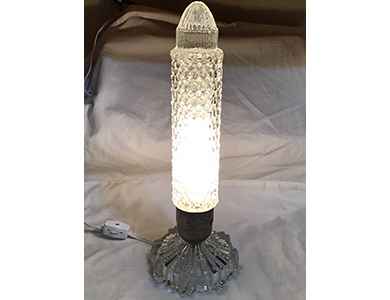
ANSWER: I was not successful in determining the manufacturer of your lamp. Imperial is a possibility, but…. The lamp is common and appears regularly for sale on eBay.com. The listings usually read: “1930s Depression Glass, Art Deco Boudoir Lamp in crystal color glass, 4 1/2 inches across the base, and 12 inches high.” Other listings included the terms “Skyscraper” or “Torpedo Bullet.” There are multiple variations of the lamp in terms of glass type (colors from translucent green and pink to opaque blue and milk glass) and base (metal as well as glass). Most appear to have started life as a pair. Individual examples in working order have a secondary market value around $20.00. A matched pair sells between $40.00 and $50.00. QUESTION: I recently inherited two (2) Chippendale mirrors that belonged to my step-parents and were housed in an Aurora, Colorado, storage unit. There are three stickers on the back. The first reads: “GBCo” / 18th Century / Chippendale.” The second label is a combined warranty and guarantee sticker: “WARRANTED / GENUINE / American Beauty / Mirror/ Trade Mark Reg. / Est. GBCo 1880 / GUARANTEE, / The workmanship and materials/ used in the marking of this mirror / are guaranteed to be of the highest / grade obtainable / No. 4053 / Size 18 x8 / Made Only By / LOUIS BIERFELD COMPANY / Chicago, Illinois.” The third label is a circular label for the “PAINE FURNITURE COMPANY / BOSTON.” I would appreciate any information you can provide about them. – FW, Email Question 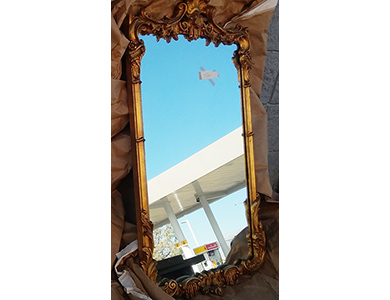
ANSWER: Although I was able to find multiple sale listings for “American Beauty” mirrors in a wide variety of design styles, I was not able to find any historical background for Louis Bierfeld Company. Based on the GBCo. monogram that appears on two of the labels, the Louis Bierfeld Company was the successor to the GBCo established in 1880. Louis Bierfeld Company made mirrors during the late 1920s and 1930s. Your two Chippendale-style mirrors are copycats (stylistic copies) of period high-style, gilded framed, English Chippendale mirrors. They are classified as Chippendale-style Colonial Revival mirrors. This copycat mirror was made by dozens of manufacturers in quality levels from fair to very good condition. The Paine Furniture Company label means the mirrors were sold initially through a Paine Furniture Company store. These stores sold Paine made furniture as well as furniture and accessories made by other manufacturers. 1930s Chippendale-style Colonial Revival mirrors are a glut on the market. Supply far exceeds demand. As a result, secondary market prices are low. A strong secondary market price, assuming the mirrors are in very good or better condition, is between $50.00 and $65.00 each. They will sell better in an urban rather than rural market. 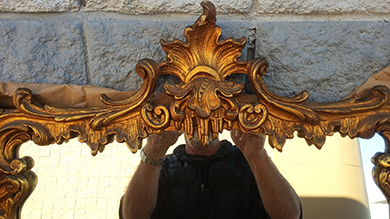
QUESTION: I have a 14-inch figure of a generic mountain man standing atop two mountain peaks. There is a “Red Mill” sticker on the bottom. I have been unable to locate another like it anywhere on the internet. Can you help me determine a value for it? – NE, Email Question 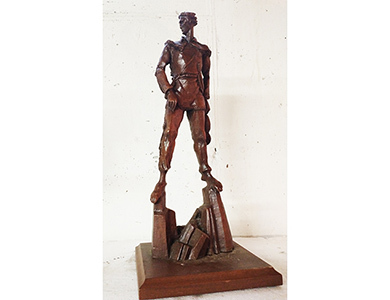
ANSWER: I could not find an identical example of the Red Mill figurine on the Internet either. I looked at more than 1,500 examples. Red Mill Manufacturing used crushed pecan shells and glue to mold three-dimensional figurines. Animals included a beaver, eagle, horse, turkey, and wolf. Human figures range from cowboys and Indians to children. When an object was removed from the mold, employees lacquered the object to enhance its color and depth. Because handwork was involved, Red Mill Manufacturing touted the individual characteristics of each piece. Although I did not find your exact Red Mill figure, I did find comparable examples. The value of your figure is between $25.00 and $30.00. This amount would be incorrect if the figure was a one-of-a-kind prototype, which I do not believe it is. If there is a Red Mill collector among my readers who can provide more information about this figure, email me at harrylrinker@aol.com. Harry L. Rinker welcomes questions from readers about
collectibles, those mass-produced items from the twentieth and twenty-first centuries.
Selected letters will be answered in this column.
Harry cannot provide personal answers.
Photos and other material submitted cannot be
returned.
Send your questions to: Rinker on Collectibles, 5955 Mill
Point Court SE, Kentwood, MI 49512.
You also can e-mail your questions to
harrylrinker@aol.com.
Only e-mails containing a full name and mailing address
will be considered.
|
||||